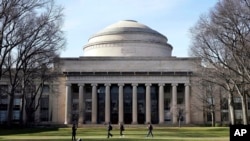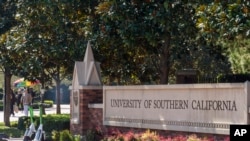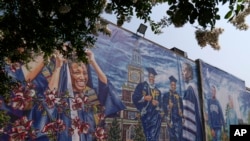Student Union
Heart Disease Seen in Some Younger COVID-19 Patients
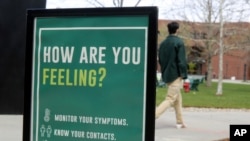
Health professionals continue to see heart disease in some young people who have had COVID-19, those who have been vaccinated against the virus, and among student athletes, in general.
Cardiomyopathy is an inflammation and weakening in the walls of the heart.
The Centers for Disease Control and Prevention (CDC) in Atlanta has reviewed vaccine safety data weekly since the start of the U.S. vaccination program and cautions that cases among those who have received the COVID-19 vaccine are “mild and few.” The agency says the condition appears in males more than females, more often following the second shot in a two-dose regimen, and usually around four days after the vaccination.
Coronavirus-related cardiomyopathy was first observed last year in younger people when college athletes resumed play as the pandemic spread in the United States. College sport events generate significant revenues for colleges and universities, and some big schools that draw thousands into stadiums returned players to campus with the hope of public events resuming sooner than later.
In a study of college athletes conducted since last September, a higher incidence of cardiomyopathy, also called myocarditis, has been seen in athletes who contracted the coronavirus, or SARS-CoV-2. Symptoms include shortness of breath, weakness, tiredness, dizziness and abnormal heart rhythm, according to the Mayo Clinic in Minnesota.
“Myocarditis is a leading cause of sudden death in competitive athletes,” researchers wrote in JAMA Cardiology in May, adding, “Myocardial inflammation is known to occur with SARS-CoV-2,” the medical name for the coronavirus.
Another study published in the Journal of the American College of Cardiology in March found that more than one in three “previously healthy college athletes recovering from COVID-19 infection showed … resolving pericardial inflammation.”
Resolving is the key word here: Researchers concluded that “no athlete showed ... features to suggest an ongoing myocarditis,” or inflammation of the heart walls. Knowing when athletes should play or rest is important, and research has not nailed down the long-term effects yet, the researchers said.
“Further studies are needed to understand the clinical implications and long-term evolution of these abnormalities in uncomplicated COVID-19,” they wrote.
Pediatric cardiologist Geoffrey Rosenthal has observed myocarditis in young people, specifically during the pandemic. He has been the team cardiologist for the University of Maryland, College Park since 2020.
“Myocarditis is one of the more common causes of sudden death in athletes,” said Rosenthal.
“If someone had myocarditis, it’s one of the standard recommendations that they not exercise strenuously for three to six months after their diagnosis to allow time for their heart to heal, and lessen their risk of a sudden event,” he said.
The residual health of athletes who have had COVID is being assessed to try to understand the risks.
Ohio State University (OSU) was one of the big universities that brought players back to campus amid the pandemic and detected heart changes in athletes who tested positive for the infection.
It has led the effort to monitor athletes by overseeing a registry of nearly 1,600 COVID-19 positive athletes in the Big Ten sports conference, or a division of 14 colleges and universities among other divisions nationally.
Looking at a smaller sample of 37 athletes diagnosed with myocarditis, 28 didn’t exhibit symptoms, reported OSU.
Rosenthal noted that research and cooperation among universities has advanced detection of myocarditis among young people and student athletes, who are largely asymptomatic, by using magnetic resonance imaging (MRI). The University of Maryland adopted cardiac MRI screening for athletes before almost all other universities in the country as the pandemic was starting, he said.
“The EKG is normal, and their blood tests are normal, and their echo [cardiogram] is OK,” Rosenthal explained. “And then we get the MRI and find out that there's an abnormality that we weren't expecting, and that we never would have found out about had we not done the MRI.
“There's still a lot of cardiac work that's going on in the younger student population,” Rosenthal said.
And this advancement in detection will help other athletes, younger and older.
“There's also hope that it will inform our understanding of COVID in older athletes, in older and non-elite athletes. … the weekend warriors,” he said.
But this research will also help non-athletes whose jobs demand physical labor.
“Other populations that these results might help inform is the military and other professions and occupations in which physical activity is part of what people are doing,” Rosenthal said. “First responders, firefighters, policemen, you know, other people whose jobs have physical demands. In addition to gaining insight into the health of our student athletes what other populations can we help through this work?”
See all News Updates of the Day
Malaysian official: Schools can’t turn away from global tensions

Zambry Abdul Kadir, Malaysia’s higher education minister, said protests spreading across universities in the United States show that schools can’t ignore political tensions.
Helen Packer, reporting in Times Higher Education, said the minister reminded educators that universities are key in the development of leaders, individuals and societies. (April 2024)
Social media breaks are difficult, but necessary

Between online classes, maintaining social connections and working on projects, college students can have a hard time disengaging from the demands of technology.
In Florida International University’s PantherNOW, Ariana Rodriguez offers strategies for taking a break from social media. (April 2024)
- By Melos Ambaye
Many master's degrees aren't worth the investment, research shows

Nearly half of master's degrees have a negative financial return, according to new research by the Foundation for Research on Equal Opportunity, an economic research organization.
The study indicates that many graduate degree programs do not increase lifetime earnings enough to be worth it.
While 23% of bachelor’s degree programs yield a negative financial return on investment, 43% of two-year degrees and master’s degrees fail to deliver a return, according to the study by Preston Cooper, a senior fellow at FREOPP.
Cooper assessed the return on investment for 53,000 degree and certificate programs to determine whether a student’s lifetime earnings outweigh program costs and the risk of not completing their degree.
His findings show that a student’s field of study was the overriding indicator of return on investment at the undergraduate and graduate level.
Engineering, computer science and nursing bachelor’s degrees have high financial returns on investment, while programs in education, fine arts, psychology and English usually have low returns.
Graduate degrees in medicine and law tend to have strong payoffs. But a large share of master’s programs, including the MBA, frequently have low payoffs, according to Cooper.
Although workers with master’s degrees earn 16% more than those with only bachelor’s degrees, Cooper says the figure fails to account for students who had “higher preexisting earnings potential.”
“MBA students typically have high preexisting earnings potential, having often chosen high-ROI undergraduate majors such as finance and economics,” Cooper writes. “So the MBA adds little value on top of that.”
The study indicates that high starting salaries are predictors of high returns on investment. Degrees with starting salaries of $57,000 a year or more deliver the best lifetime returns.
But the return on investment of a degree can vary depending on the educational institution.
“Students interested in fields with low average pay can still find some schools that do well transforming those fields of study into high-paying careers,” Cooper writes.
The quality of an institution also matters, said William Tierney, professor emeritus of higher education at the University of Southern California.
“An MBA from Harvard is a likely ticket to a good job,” Tierney told VOA. “An MBA from the University of Phoenix, less so.”
But students pursue graduate programs for more than just financial reasons.
“Some degrees open up careers in fields that students may enjoy, such as in the performing arts,” Robert Kelchen, head of educational leadership at the University of Tennessee, Knoxville, told VOA.
“Others can help gain access to social networks or simply help students learn about a topic that is of interest,” Kelchen added.
Cooper told VOA that it might make sense for students in degree programs with low returns on investment to switch majors if they can still graduate on time.
He found the worst outcome for a student’s return on investment is dropping out of college “because they must pay for one or more years’ tuition and spend time out of the labor force.”
Lawmakers who fund higher education have a responsibility in ensuring “higher education delivers on its promise of economic mobility,” Cooper said.
Nearly a third of federal funding, including Pell grants and student loans, pays for higher education programs that fail to provide students with a return on investment, according to the study.
Cooper’s view is that “some schools should shut down low-ROI programs and reallocate institutional resources to programs with a better return.”
“There's definitely this narrative out there that higher education is always worth it, and you should always try to get that extra degree because it will increase your earnings,” he told VOA. “That's reinforced by colleges who make lofty promises regarding their graduate degree programs' outcomes, which all too often fall short.”
Harvard students end protest as school agrees to discuss Gaza conflict

Protesters against the war between Israel and Hamas were voluntarily taking down their tents in Harvard Yard on Tuesday after university officials agreed to discuss their questions about the endowment, bringing a peaceful end to the kinds of demonstrations that were broken up by police on other campuses.
The student protest group Harvard Out of Occupied Palestine said in a statement that the encampment "outlasted its utility with respect to our demands." Meanwhile, Harvard University interim President Alan Garber agreed to pursue a meeting between protesters and university officials regarding the students' questions.
Students at many college campuses this spring set up similar encampments, calling for their schools to cut ties with Israel and businesses that support it.
The Israel-Hamas war began when Hamas and other militants stormed into southern Israel on October 7, killing some 1,200 people and taking 250 hostages. Palestinian militants still hold about 100 captives, and Israel's military has killed more than 35,000 people in Gaza, according to Gaza's Health Ministry, which doesn't distinguish between civilians and combatants.
Harvard said its president and the dean of the Faculty of Arts and Sciences, Hopi Hoekstra, will meet with the protesters to discuss the conflict in the Middle East.
The protesters said they worked out an agreement to meet with university officials, including the Harvard Management Company, which oversees the world's largest academic endowment, valued at about $50 billion.
The protesters' statement said the students will set an agenda that includes discussions on disclosure, divestment, reinvestment and the creation of a Center for Palestine Studies. The students also said that Harvard has offered to retract suspensions of more than 20 students and student workers and back down on disciplinary measures faced by 60 more.
"Since its establishment three weeks ago, the encampment has both broadened and deepened Palestine solidarity organizing on campus," a spokesperson for the protesters said. "It has moved the needle on disclosure and divestment at Harvard."
Chinese students report interrogations, deportations at US airports
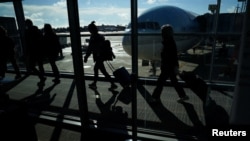
Academics from China are reporting increased scrutiny at U.S. airports, with valid visa holders being interrogated and turned away by Customs and Border Protection Agents.
Phones and laptops have been searched, and researchers have undergone extensive questioning about their work. One graduate student at Yale, who was midway through her PhD, was turned back at Dulles airport and banned from entering the U.S. for five years, according to The Guardian.




